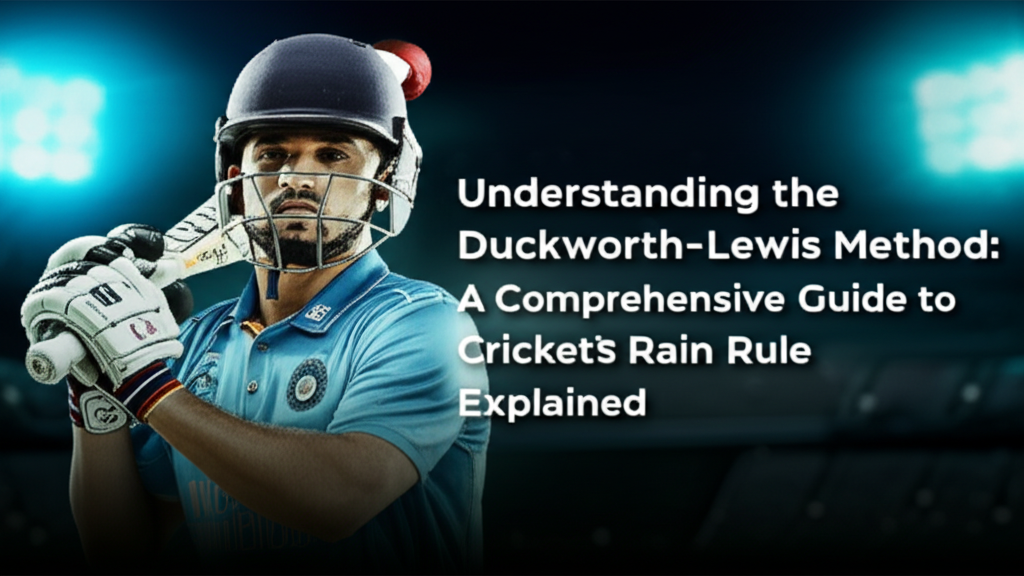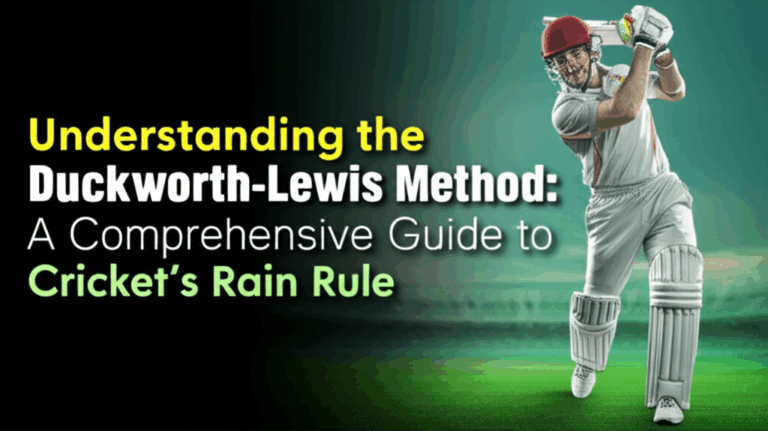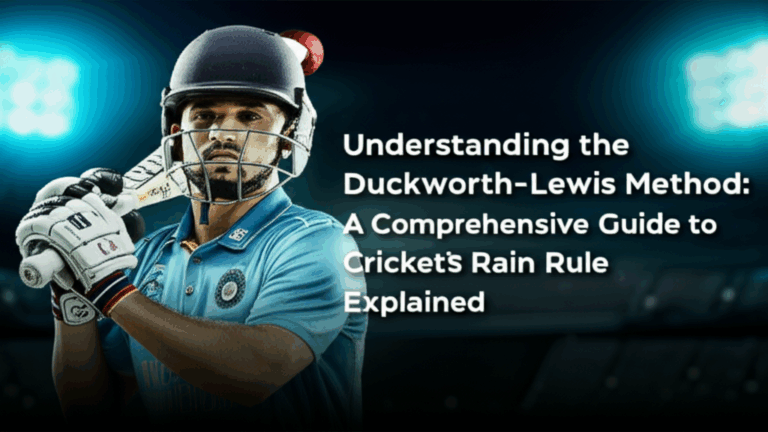
Cricket, a game steeped in tradition, has a unique charm that captivates millions around the globe. However, one of the most frustrating aspects of this beloved sport is when rain disrupts a match. Imagine the excitement of a nail-biting game suddenly halted by an unexpected downpour! To tackle this issue, cricket has adopted the Duckworth-Lewis Method (DLM), a mathematical formula designed to adjust scores in rain-affected matches. In this article, we will dive deep into understanding the Duckworth-Lewis Method, exploring its components, benefits, and practical applications.
The value of understanding the DLM cannot be overstated. It ensures that matches remain fair and competitive, even when the weather plays spoilsport. Whether you’re a casual fan or a seasoned player, knowing how this method works can enhance your appreciation of the game. Throughout this article, we will break down the intricacies of the DLM, shed light on its importance, and provide examples of how it has been implemented in real-life scenarios. By the end, you’ll feel more informed and equipped to discuss this fascinating aspect of cricket with confidence!
Understanding the Duckworth-Lewis Method
The Duckworth-Lewis Method was devised by statisticians Frank Duckworth and Tony Lewis in the mid-1990s. It was introduced to the world of cricket as a means to calculate target scores in limited-overs matches when interruptions occur, typically due to rain. The method considers two key factors: the number of overs remaining and the number of wickets in hand at the time of the interruption. This approach aims to make the game as fair as possible under changing conditions.
At its core, the DLM operates on the principle that different teams have varying capabilities and resources. By assessing the current state of the match, the DLM helps to adjust the target score in a way that reflects the actual playing conditions. This statistical model can seem complex, but once you break it down, it becomes easier to understand.
The Mathematical Backbone
To fully grasp how the DLM works, we need to look at the mathematical framework behind it. The method uses a resource table that quantifies the resources available to both teams at any given point in the match. The resources are quantified in terms of overs and wickets left, creating a percentage of resources available to each team.
- Overs Remaining: This refers to the number of overs left for the batting team at the time of interruption.
- Wickets in Hand: This refers to the number of wickets the batting team still has available.
The formula essentially calculates the percentage of resources available to each team and adjusts the target score accordingly. For instance, if a team is chasing a total of 250 runs and they have lost 3 wickets with 20 overs left, the DLM will determine how many runs they should have scored at that point based on the resource table. If rain interrupts play and they have to chase a revised target, the DLM will use these calculations to ensure fairness.
Key Components of the Duckworth-Lewis Method
Understanding the DLM requires familiarity with its key components. Here’s a breakdown of the most significant elements that contribute to the method’s effectiveness:
1. Resource Tables
The DLM relies heavily on resource tables that outline the percentage of resources available based on overs remaining and wickets in hand. These tables are meticulously calculated and updated for different conditions and formats of the game. For example, if a team has 30 overs left and has lost 5 wickets, the resource table will provide a corresponding percentage indicating how much of their innings they have effectively used.
2. Revised Target Calculation
When rain intervenes, the DLM calculates a new target based on the resources available to both teams. This ensures that the chasing team has a fair opportunity to win the match, reflecting the conditions they faced. The revised target is determined by applying the resource percentages from the tables to both teams’ scores.
3. The Role of Wickets
Wickets play a crucial role in the DLM. The fewer wickets a team has in hand, the more challenging their chase becomes. This aspect is essential because it influences the team’s strategy and approach to batting. If a team has lost several wickets, they might be more cautious in their run chase, knowing that they cannot afford to lose more batsmen.
4. Limited-Overs Formats
The DLM is primarily designed for limited-overs formats, such as One Day Internationals (ODIs) and Twenty20 matches. The reason for this is straightforward: these formats have fixed overs, which makes it easier to determine how much of the innings has been completed at the time of the interruption. In contrast, Test matches, which are played over five days, follow a different set of rules and do not require such a method.
Benefits and Importance
The Duckworth-Lewis Method serves several vital purposes in the world of cricket. Understanding its benefits can help you appreciate why it was developed and how it has transformed the game:
1. Fairness in Competition
One of the primary benefits of the DLM is its ability to maintain fairness in matches that have been interrupted by rain. By adjusting scores based on resources available, the method ensures that both teams have an equitable chance of winning, regardless of the weather conditions.
2. Enhanced Spectator Experience
For fans, the DLM adds an element of excitement. Instead of simply calling off a match due to rain, spectators can witness the drama of a revised target chase. This keeps the audience engaged, even in adverse weather conditions, and maintains the competitive spirit of the game.
3. Strategic Depth for Teams
The DLM also introduces a strategic layer for teams. Captains and coaches must be aware of how the method works to make informed decisions during matches. Knowing when to be aggressive or cautious can make a significant difference in the outcome, especially when rain is forecasted.
4. Clear Guidelines for Umpires
The DLM provides umpires with a clear and structured approach to resolving rain interruptions. This eliminates ambiguity and allows officials to make quick and accurate decisions, which is crucial for maintaining the flow of the game.
Practical Applications
Now that we’ve discussed the theoretical aspects of the Duckworth-Lewis Method, let’s delve into some practical examples that illustrate how it works in real cricket matches.
Case Study 1: World Cup Drama
One of the most memorable instances of the DLM in action occurred during the 1996 Cricket World Cup. In a crucial quarter-final match between Sri Lanka and India, rain interrupted play, leading to a revised target for Sri Lanka. Initially set to chase 252 runs, the DLM adjusted their target to 209 runs in 40 overs. Sri Lanka went on to win the match, showcasing the effectiveness of the DLM in facilitating a fair outcome.
Case Study 2: An IPL Encounter
In the Indian Premier League (IPL), the DLM has also played a significant role. During a match between the Chennai Super Kings and the Kolkata Knight Riders, rain interrupted the game, and the DLM was used to set a revised target for the Super Kings. Fans witnessed a thrilling chase, and the strategic decisions made by both teams added to the excitement of the match.
Frequently Asked Questions
What is the Duckworth-Lewis Method?
The Duckworth-Lewis Method (DLM) is a mathematical formula used in cricket to calculate target scores in limited-overs matches that are interrupted by rain or other factors. It considers the number of overs remaining and the wickets in hand to ensure that both teams have a fair chance of winning, regardless of the playing conditions.
How does the DLM work?
The DLM works by utilizing resource tables that quantify the available resources for both teams. When rain interrupts a match, the DLM calculates a revised target for the chasing team based on the percentage of resources they have at the time of the interruption, ensuring the match remains competitive.
Why is the DLM important in cricket?
The DLM is crucial for maintaining fairness during rain-affected matches. By providing a structured way to adjust targets, it enhances the spectator experience, introduces strategic depth for teams, and allows umpires to make quick decisions, all while ensuring the spirit of the game remains intact.
Can the DLM be applied to Test matches?
No, the DLM is primarily designed for limited-overs formats, such as One Day Internationals (ODIs) and Twenty20 matches. Test matches follow a different set of rules and do not require a method like the DLM since they can be played over five days without fixed overs.
What happens if the rain continues throughout the match?
If rain continues throughout the match, the umpires may call off the game. In such cases, the result may be determined based on the scores at the last completed over or through a “no result” declaration, depending on the specific tournament rules and conditions.
Are there any alternatives to the DLM?
Yes, there are alternative methods, such as the VJD Method, which is used mainly in domestic tournaments in India. However, the DLM is the most widely recognized and accepted method for international matches due to its rigorous statistical backing and comprehensive resource tables.
Conclusion
To wrap things up, the Duckworth-Lewis Method is a remarkable innovation in the world of cricket, ensuring that the game remains fair and exciting, even in the face of unpredictable weather. By understanding this method, you not only enhance your knowledge of cricket but also appreciate the strategic nuances that come into play during rain-affected matches. So, the next time you’re watching a match and the skies turn gray, remember the DLM and how it works to keep the spirit of competition alive!
If you found this article helpful, consider sharing it with fellow cricket enthusiasts. Engaging in discussions about the DLM can enhance your understanding and appreciation of the game. Whether you’re a player, coach, or fan, embracing the intricacies of cricket can deepen your love for this beautiful sport. Happy watching, and may your favorite team always emerge victorious, rain or shine!





